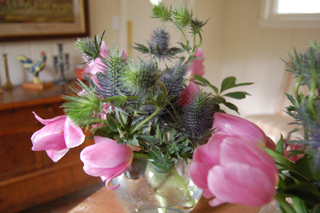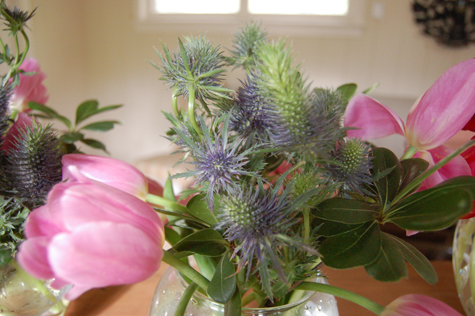Human Flower Project
Saved by the Eryngium
Seduced again by tulips, an amateur flower arranger reaches for something rubbery and something wild.

Pittisporum, tulips, and (praise be) eryngium
Photo: Human Flower Project
Hubris, failure, luck: The annals of amateurism are filled with these.
May we add another chapter? Today is a friend’s monumental birthday, a milestone we have yet to reach. Another great chum and world-class hostess is having the quasi-surprise party, a dinner at her home, and we volunteered to bring the flowers. Earlier in the week we hit “Family Thrift” and the St. Vincent de Paul store looking for some low, matchable-ish vases and today set out at noon to shop for flowers.
The hostess’s domain is saturated in bold rich colors: black, deep purple, reds, greys and dark greens. We had those regal shades in mind browsing the plants and flowers at the market. Five big purple and white orchids would have been swell but we pulled back. They’re pricey and so tall guests would be craning for conversation during the meal. The market was especially well stocked — many shades of roses, proteas buds (looking a bit too much like medieval flame throwers), lilies, lots of berries, even big purpling bouquets of kale.
There were also loads of tulips—white, red and purple—some tear-drop tight, other beautifully open. That was it. We bought five bunches and, on added impulse, several stems of a thistle-looking plant. As several tulip petals flew off in the wind on the way to the car, hubris began chafing.
Back home we settled the tulips and thistles into a kettle of lukewarm water, grabbed clippers and headed out to the yard for pittisporum leaves, a super companion for about any flower. They actually grow radially and look like green florets, shiny and less klunky than magnolia leaves. Thanks to a heavy rainshower yesterday, the little branches were especially fresh.
Ah, assembly! Yes, we had vaguely anticipated there might be a problem getting the flowers to stand up in these glass globes (which is why most arrangements you see with these vases are packed in a la sardine). Wasn’t there a wad of chickenwire somewhere? There was a tussle with the wire cutters – spousal instructions somewhat helpful. There were several attempts at chickenwire application – on the bottom of the vase? on the top? under the top? inverted? None too sure of the armature, we plunged ahead, dissolving the little packets of plant food in water and ripping the cellophane sacks from the tulips.
Clipping the bottoms of the stems and dropping them into the glass vases, we heard an old, familiar whine in the distance – the big Failure siren was closing in! How could we have forgotten the great defect of tulips. Their terrible posture!
The next 20 minutes were frenzied, angry, self-recriminating. Each arrangement looked worse than the last, as if the flowers had all been stricken with palsy and were now trying to slink their way out of this social obligation altogether. (We know the feeling.) Did we need to “wire” the tulips so their heads would stand up? Who has time to wire 50 flowers, and who with two centuries of time knows how to do that anyway?
By reflex, we reached for one of those tools of desperation—in the same kit-bag as the staple gun and Krazy Glue: the rubber band. We bunched and banded the pittisporum branches and tulips together like pony tails and replopped them in the vases. Pretty bad, but less awful. Now at least some of the flower heads were upright.
The kettle in the sink still held two big bunches of thistle. What the hell. We pulled that out, chopped it it off and dropped several stems into each vase. And all that had been so feeble before suddenly was passable. These flowers now, as T.S. Eliot once put it, “had the look of flowers that are looked at.” (You might even miss the old brown rubberbands.)

Blue eryngium—though which blue eryngium, we’re not sure—gives a boost to langourous tulips
Photo: Human Flower Project
We had been saved by Blue Eryngium, a plant we’d seen growing wild before but known nothing about. It turns out that sea holly, as its more commonly known, grows well in Texas, and you can be sure we’ll be looking for some to plant in the garden. The spinyness of it, the bluish cone shapes and slight duskiness were ideal here, a fine contrast to both the deluxe color and droopiness of the tulips and the shiny pinwheel green of pittisporum.
And talk about good posture!
Geyata Ajilvsgi in Wildflowers of Texas describes Egyngo (Eryngium leavenworthii) as “upright, rather slender, prickly.” Which also perfectly describes tonight’s guest of honor. We hope she’ll be pleased.
Comments
Dear Allen,
Thank you, thank you, for all this added information about how to get Eryngium seed—and your own fascinating efforts to make that seed more widely available. If only we could get florists working more closely with local growers, and make the best of our bounty!
I’d also be interested to know how leavenworthii differs in looks and hardiness from the eryngium perennials.
We always welcome your tales of untold horticulture.
X
J.
Hey, Julie—
The flowers of Eryngium leavenworthii resemble other Eryngo species but have flowering parts with a color range from white to steel blue to purple. Most can be recognized by their prominent flowering cone and decorative bracts that resemble petals. Hardiness is largely a function of native provenance. This rain-soaked summer E. leavenworthii got a little ungainly in Kentucky. I pinched mine once or twice so they wouldn’t get tall and floppy. My guess is that they’re adapted to dry summers.
We’ve finally gotten a hard frost…
Allen


I’m glad your bouquet worked-out for the special birthday! I fell in love with Eryngium leavenworthii the first time I saw plants in a garden on the east coast six or eight years ago. I got some seeds from the North American Rock Garden Society seed exchange the next winter. I hoped that Jelitto Perennial Seeds, my employer, might be able to offer this for sale one day. I needed to grow a few plants to produce seeds for their trials. I imagined it wasn’t well known outside its native range. Though Jelitto offers a wide selection of perennials, including quite a few perennial Eryngiums, annuals are not a big focus. And Eryngium leavenworthii is an annual but a beautiful species. It flowers, sets seed and dies after one season. However, it does self-sow in my dry scree garden but they sometimes take two years to germinate. That’s not so unusual for some perennials but it’s not a big selling point for an annual. Seed production stalled. One day I walked across the street from the Jelitto office to the coffee shop and found an arrangement of these gorgeous blooms. I asked where they’d gotten them. I was astonished to see them here. They said one of the local wholesale florists delivered them. The clerk had no idea which one. I wondered if they might be locally produced. After a random search (No one knew the cut flower by Eryngium or Sea Holly) I finally tracked down the local wholesaler after describing the flowers. He told me they’d come from a South American cut flower grower! Jelitto was eventually able to offer seed in their catalog.